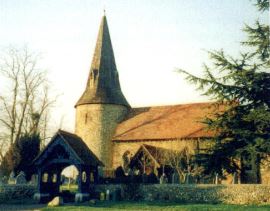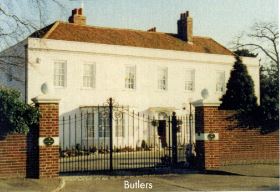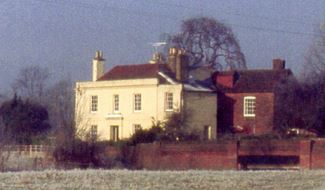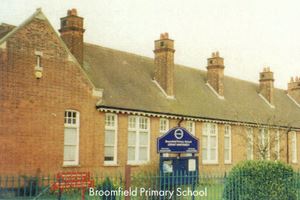Broomfield is more than just a name, it is a community with a history going hack far beyond the first record of the name. It was Brumfelda in 1086 but people had been living here long before that. Flint arrowheads, Celtic coins and other artifacts testify to pre Roman occupation. The Romans were here too. A villa of some importance was established here; more than Roman coins have been unearthed, together with brooches and equine artifacts. The walls of the church contain many large Roman bricks and tiles. Broomfield Hall was a Saxon foundation, which, together with Patching Hall and Belstead Hall, became the foundation of the village of Broomfield. Patching Hall was the largest of the Saxon manors and a 7th century burial on its land indicates that it was the home of a wealthy leader. Some of the grave goods, garnet and gold, blue glassware, bear a resemblance to the famous find at Sutton Hoo and the iron lamp found in the grave is larger than its Sutton Hoo counterpart!

The church of St Mary with St Leonard dates back to the end of the 11th century, its prominent round tower being added a few years later. The nave, tower, and part of the chancel are Norman. The chancel was extended around 1430. A line of Roman tiles clearly shows where the original building ended. It was also in the 15th century that the church acquired its porch and spire. A curious feature of the church is the “pudding stone” in the south wall of the nave: not unique, as there are other bits in the walls but the reason for its being deliberately placed to protrude so far has yet to be convincingly explained. Inside, the fine 13th century stone font has had a chequered career; thrown out during the Commonwealth period (1653-58), it turned up again in 1843 and was restored to the church.

Reminders of Broomfield’s past can be seen in its many old buildings. Broomfield was an agricultural community and so it inevitably had farmhouses, several of which have been rebuilt over the ages to reflect the changes in taste and prosperity. Broomfield Hall has 15th century timbers; Priors is a fine 16th century building; Butlers was rebuilt in the 1780s in the fashionable Georgian style; Stacey’s was also rebuilt at around the same time; Scravels, still an old timber-framed building, was given a Victorian exterior. Of Broomfield’s five “Greens”, three have the atmosphere of a village green. Parsonage Green has its pond and the Parsonage with its superb tithe barn. Angel Green has the 15th century Angel public house and the backdrop of the grounds of Broomfield Place, while the buildings around the attractive Church Green span some 900 years!

Woollards, on the south side of Church Green, is a reminder that this was once a row of cottages given by a wealthy benefactor for the benefit of the poor of Broomfield forever. The cottages were eventually sold and the proceeds invested to give an income, which is still put to charitable uses in the parish. Much of the past can still be seen in Broomfield’s countryside, a valuable part of the community today. The river forms an attractive feature of the parish and there was a mill here in 1086. The mill is no more but the miller’s house remains beside the river, where the weir still gives the fall of water to drive the long gone wheel.

The countryside is still criss-crossed with footpaths, which once served to join homesteads, the mill, and the church. There is even history here; the footpath that goes across the fields from Goulton Road to the church was granted as a right of way by the Lord of the Manor, SirThomas de Mandeville, in 1294.

Education has a long history in Broomfield. In 1708 it was noted “Ric Gyles have leave to keep Scoole in the Vestry and that he lett none of the schollrs goe into the Church”. In 1709 the parish agreed to pay 3d a week for the schooling of Widow Parter’s boy. In 1715 the schoolmaster, an outsider, was sent back to his parish lest he became a charge on Broomfield if he became sick. In 1760 the parish register records the burial of a boy, “a boarder at the school at New House” (now Broomfield Place). In 1831 Thomas Christy provided a purpose built school near Parsonage Green, and in the 1850s there was a school in one of the outbuildings of the Parsonage. Broomfield’s population has increased dramatically in recent years. There were 36 tenants on the Broomfield manors in 1066, perhaps giving a total population of around 150 people. By the 16th century the number of entries in the parish register suggests a population of 300- 400, and by 1801 it had risen to 467.
The 1891 census put the figure at just under 900 and 100 years later in 1991, it had reached 3,911. With ever greater expansion planned for the hospital, the number will doubtless continue to rise, and our heritage of countryside and village greens will become ever more precious.
–Ken Searles
